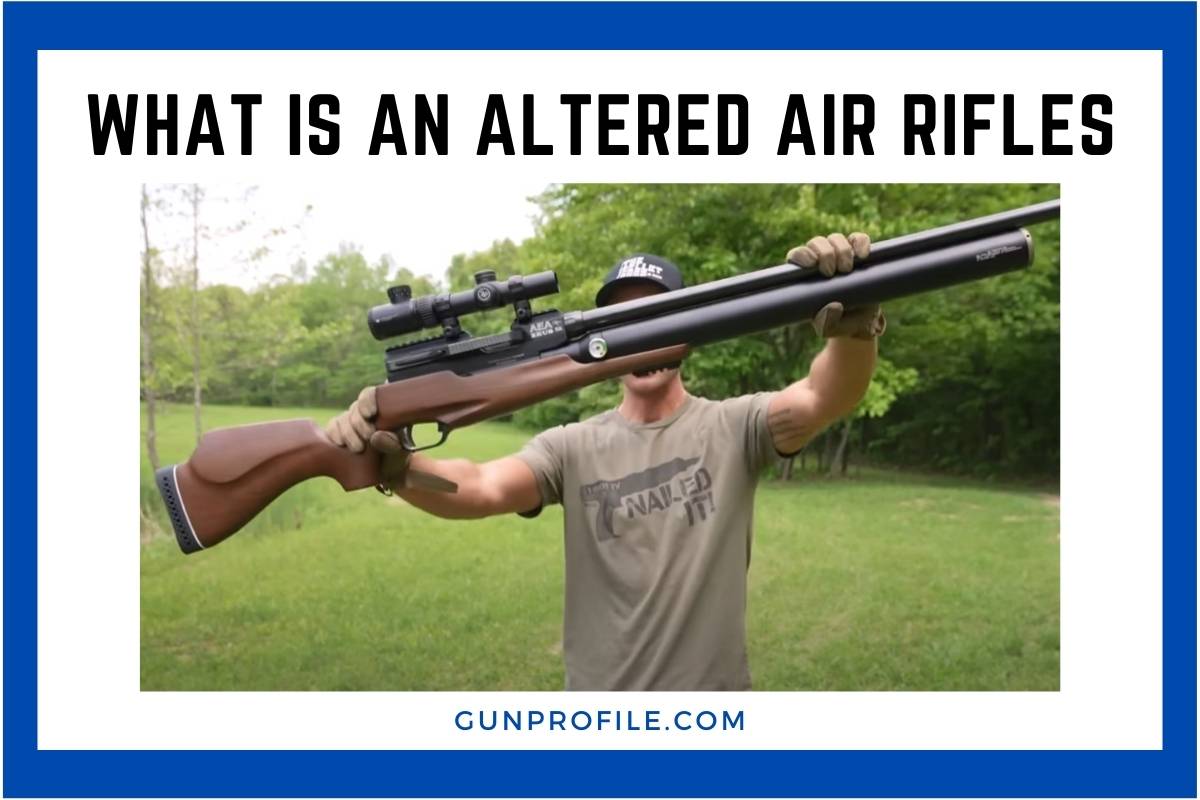Altered air rifles are modified versions of standard air guns. These changes aim to enhance the rifles’ performance or capabilities. These modifications can range from simple tweaks to major overhauls of the rifle’s internal components.
Altered air rifles often have improved power, accuracy, or consistency compared to their original factory specifications.
Many air gun enthusiasts enjoy customizing their rifles to suit their specific needs or preferences. Some common alterations include upgrading the trigger mechanism, changing the barrel, or adding a regulator.
These changes can significantly impact the rifle’s shooting characteristics and make it more suitable for various purposes like target shooting or hunting small game.
It’s important to note that altering air rifles may have legal implications in some areas. Before making any modifications, it’s crucial to check local laws and regulations regarding air gun power and modifications. Safety should always be a top priority when handling and modifying air rifles.
Definition and Design of Altered Air Rifles
Altered air rifles are modified versions of standard air guns. These changes aim to improve performance, accuracy, or power beyond the original design.
Understanding Air Rifles
Air rifles use compressed air to shoot pellets. They come in different types, like spring-piston and pre-charged pneumatic. Spring-piston rifles store energy in a spring, while pre-charged models use compressed air tanks.
Most air rifles have a simple design. They have a barrel, a compression chamber, and a trigger mechanism. The barrel breaks open to cock the gun in many models.
Air rifles can be powerful and accurate. They’re used for target shooting, hunting small game, and pest control. Many shooters like them because they’re quieter than firearms.
Modifications Explained
Altering air rifles involves changing their original parts or design. Common mods include:
- Barrel upgrades for better accuracy
- Trigger improvements for smoother shooting
- Power adjustments to increase velocity
Some changes focus on the air compression system. This can involve new valves or regulators, which can boost power and shot consistency.
Other alterations might include:
- Custom stocks for better fit
- Enhanced sights or scopes
- Noise reduction systems
It’s important to note that some mods may affect the gun’s safety or legal status. Shooters should check local laws before altering their air rifles.
Legal Aspects
Air rifles have unique legal considerations. Rules vary by location and type of air rifle. Understanding the laws helps ensure proper and legal use.
Regulatory Framework
In the United States, most air rifles are not considered firearms by federal law. They don’t use explosive propellants like traditional guns. This means they aren’t regulated by the Bureau of Alcohol, Tobacco, Firearms and Explosives (ATF).
But some air rifles can be classified as firearms. This happens if they:
- Exceed certain power levels
- Are modified from actual firearms
- Meet specific velocity or caliber criteria
Local and state laws may have stricter rules. Some places treat all air rifles as firearms, regardless of power.
Ownership and Use Laws
Air rifle laws differ widely between states and countries. Many areas allow adults to own air rifles without a license. But there are often restrictions on use and transport.
Common regulations include:
- Age limits for purchase and use
- Prohibitions on carrying in public
- Rules against shooting in city limits
Some places require air rifles to be registered. Others ban certain types or power levels. Hunting laws may limit air rifle use for taking game.
It’s crucial to check local laws before buying or using an air rifle. Penalties for misuse can be severe, even if unintentional.
Safety Considerations
Proper safety practices are crucial when dealing with altered air rifles. Modifications can affect the gun’s performance and potential risks, making careful handling and assessment essential.
Handling and Storage
Air rifles must be treated with the same respect as firearms. Always point the muzzle in a safe direction, even when the gun is not loaded. Keep your finger off the trigger until ready to shoot.
Store altered air rifles in a secure, locked location away from unauthorized users. Use a gun safe or lockable cabinet. Ensure ammunition is stored separately.
When transporting, use a hard case and follow local laws. Never leave an altered air rifle unattended in a vehicle.
Regular maintenance is key. Clean and inspect the rifle after each use. Check for wear or damage, especially on modified parts.
Risk Assessment of Modifications
Alterations can change an air rifle’s power, accuracy, and safety features. Evaluate each modification carefully. Increased power may require stronger safety measures.
Consider potential failure points. Modified parts may wear faster or react differently under stress. Test the rifle thoroughly after any changes.
Be aware of legal implications. Some alterations could make the rifle illegal in certain areas. Research local laws before making modifications.
Seek expert advice for complex alterations. A gunsmith can assess safety risks and ensure proper installation of new components.
Always use appropriate protective gear when shooting an altered air rifle. Eye and ear protection are essential, as modifications may increase noise or debris.
Performance and Usage
Altered air rifles offer enhanced accuracy and power compared to standard models. They are used for both competitive shooting and recreational purposes, with customizations tailored to each application.
Enhancing Accuracy and Power
Altered air rifles often have upgraded barrels and triggers for better accuracy. Precision-made barrels improve shot consistency. Adjustable triggers allow for a lighter, crisper pull.
Some modifications boost power. Larger air reservoirs or higher-pressure systems increase velocity. Heavier pellets can be used for more impact energy.
Scopes and sights are commonly upgraded. High-quality optics improve target acquisition and long-range accuracy.
Competitive and Recreational Use
In competitions, altered air rifles excel in precision events. Shooters can fine-tune their rifles to match specific course requirements.
For recreational use, these rifles offer versatility. They can be set up for:
- Target practice
- Small game hunting
- Pest control
Semi-automatic models are popular for fast follow-up shots. Some altered rifles can shoot larger calibers like .45 or .50, increasing their effectiveness for hunting.
Safety features are often enhanced on altered rifles. This includes improved safeties and pressure relief valves.
Maintenance of Altered Air Rifles
Keeping altered air rifles in top shape requires regular care and attention to detail. Proper maintenance ensures optimal performance and longevity of these modified weapons.
Routine Upkeep
Cleaning and oiling are key to maintaining altered air rifles. Clean the barrel after every use with a proper cleaning rod and patches. Oil moving parts lightly to prevent rust and ensure smooth operation.
Check seals and O-rings regularly for wear or damage. Replace them promptly if issues are found. This helps maintain proper air pressure and accuracy.
Inspect the stock for cracks or loose fittings. Tighten any loose screws and treat wooden stocks with a suitable oil to protect against moisture.
Store the rifle in a cool, dry place. Use a gun cabinet with a corrosion inhibitor to prevent rust. Keep the rifle in a padded case when not in use to protect it from bumps and scratches.
Troubleshooting Common Issues
Low power or inconsistent shots often indicate seal problems. Check and replace seals if necessary. Lubricate the pump or CO2 mechanism to ensure smooth operation.
If accuracy declines, examine the barrel for dirt or damage. Clean thoroughly or seek professional help if issues persist. Scope lenses can be treated with rain repellent to maintain clear sights in wet conditions.
Strange noises or vibrations may signal loose parts. Inspect all screws and fittings, tightening as needed. Pay special attention to any modified areas of the rifle.
For spring-piston models, listen for spring noise. Excess noise might mean the spring needs lubrication or replacement. This task often requires professional assistance due to the high tension involved.
Frequently Asked Questions
Altered air rifles have specific uses, legal distinctions, and ownership regulations. Their mechanisms differ from air pistols, and certain criteria determine if they’re unregulated. Some people prefer sniper air rifles for particular reasons.
What purposes are altered air rifles typically used for?
Altered air rifles are often used for target shooting and pest control. They can be effective for small game hunting as well. Some enthusiasts modify air rifles to increase power or accuracy for competitive shooting events.
What is the legal distinction between an air gun and a firearm?
Air guns use compressed air or gas to propel projectiles, while firearms use combustion of gunpowder. This difference typically means air guns face fewer legal restrictions. However, laws vary by location, and some powerful air rifles may be regulated similarly to firearms.
Are there restrictions on owning air rifles for individuals with felony convictions?
Many jurisdictions allow felons to own air rifles, as they’re not classified as firearms. But laws differ by state and country. Some areas may restrict high-powered air rifles for felons. It’s crucial to check local laws before purchasing.
How does an air rifle differ from an air pistol in terms of mechanism and use?
Air rifles generally have longer barrels and stocks, providing better accuracy and power than air pistols. Break barrel air rifles use a unique cocking mechanism, while air pistols often use CO2 cartridges. Rifles are typically used for longer-range shooting and hunting.
What criteria are used to determine if an air rifle is considered unregulated?
Criteria often include muzzle velocity, caliber, and power source. Many places set specific limits, like 12 ft-lbs of muzzle energy in the UK. Some areas regulate air rifles based on their appearance or ability to be converted to firearms.
Why may one choose a sniper air rifle over other types of air rifles?
Sniper air rifles offer enhanced accuracy and range. They’re popular for precision target shooting and long-range pest control. These rifles often feature high-quality optics and adjustable stocks. These features improve stability and performance at greater distances.

